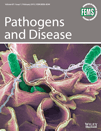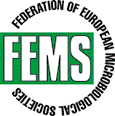Journal list menu
Export Citations
Download PDFs
Issue Information
Editorial
Launching PAD (Pathogens and Disease): more than a new title!
- Pages: 1-2
- First Published: 05 January 2013
Letter to the Editor
Why was Desulfovibrio fairfieldensis not found in faecal DNA from patients with gastric disease?
- Page: 3
- First Published: 05 January 2013
Molecular Pathogenesis
Research Article
Lack of antigenic diversification of major outer membrane proteins during clonal waves of Neisseria meningitidis serogroup A colonization and disease
- Pages: 4-10
- First Published: 19 October 2012
This very interesting study compares outer membrane protein sequences in a number of Neisseria meningitidis serogroup.A disease and carriage isolates from a defined region or subsaharan Africa between 2002 and 2008. It concludes that there is a remarkable antigenic stability in this population and that herd immunity is not a strong driving force for antigenic diversification. The study is well conceived and carried out, the results are clearly presented and the conclusions pertinent.This is important and useful information
Cytotoxicity of Clostridium difficile toxin B does not require cysteine protease-mediated autocleavage and release of the glucosyltransferase domain into the host cell cytosol
- Pages: 11-18
- First Published: 14 January 2013
This is an excellent, paradigm-shifting in Clostridium difficile toxin-mediated pathogenesis. The data are excellent.
Staphylococcus aureus mutants lacking cell wall-bound protein A found in isolates from bacteraemia, MRSA infection and a healthy nasal carrier
- Pages: 19-24
- First Published: 10 January 2013
Truncated SpA, not anchored to the cell wall, can still be found during carriage or infection, underlining the fact that there is no single virulence factor in Staphylococcus aureus that is required for generating a specific type of infection
Microbial Communities in Infection and Disease
MiniReview
Microbial biofilms and gastrointestinal diseases
- Pages: 25-38
- First Published: 29 January 2013
This timely review on the significance of microbial biofilms and gastrointestinal disease will stimulate research in this field.
Research Article
Eradication of Pseudomonas aeruginosa biofilms on cultured airway cells by a fosfomycin/tobramycin antibiotic combination
- Pages: 39-45
- First Published: 10 January 2013
This is an interesting study where Pseudomonas aeruginosa biofilms were grown on CF airway epithelial cells to study the synergistic effect of Fosfomycin/Fobramycin formulas (FTI) for Inhalation treatment of infection on biofilm formation. FTI holds promise for treatment of chronic airway infection and in this work it is clear that there is a significant effect on biofilm formation under in vivo like conditions investigated.
Host Responses to Infection
MiniReview
Dendritic cell function in the host response to Helicobacter pylori infection of the gastric mucosa
- Pages: 46-53
- First Published: 22 January 2013
This MiniReview concisely summarizes the evidence that dendritic cells play an important role in modulating T cell responses to Helicobacter pylori infection, primarily through the development of regulatory T (Treg) cells, which may limit the gastritis associated with this infection.
Research Article
Cord-forming mycobacteria induce DNA meshwork formation by human peripheral blood mononuclear cells
- Pages: 54-66
- First Published: 19 October 2012
This study investigates the response of human blood mononuclear cells (PBMCs) to a cord-forming strain of Mycobacterium abscessus. A fibrous chromatin-like meshwork containing DNA and histones is produced by the PBMCs,perhaps as a defense mechanism against other invaders. Overall very nicely done and with well-illustrated results.
Omics and Systems Biology
Research Article
Time-course proteomic profile of Candida albicans during adaptation to a fetal serum
- Pages: 67-75
- First Published: 19 October 2012
This work uses state-of-the-art proteomics methodology (LC-MS/MS) to examine the growth of the important pathogen,Candida albicans, as it adapts to fetal serum. They identify several proteins that may be candidate virulence factors.
Translational Research
Research Article
Green tea epigallocatechin-3-gallate attenuates Porphyromonas gingivalis-induced atherosclerosis
- Pages: 76-83
- First Published: 19 October 2012
This is a very interesting and relevant study that demonstrates the ability of epigallocatechin-3-gallate (EGCG), a polyphenol extract from green tea, to protect against Porphyromonas gingivalis-induced atherosclerosis. The experimental approach is straightforward and the results provide evidence for the mechanism accounting for the protective effect.
Short Communication
Alterations of penicillin-binding proteins in pneumococci with stepwise increase in β-lactam resistance
- Pages: 84-88
- First Published: 11 December 2012
This paper provides a comprehensive database of penicillin-binding protein mutations associated with b-lactam resistance in Streptococcus pneumoniae.





